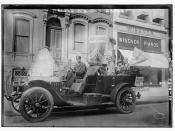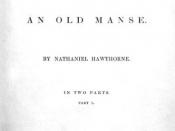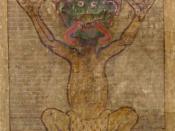The stories "Young Goodman Brown" by Hawthorne and "The Man in the Black Suit" by King are very similar and touch upon many of the same key points in literature, including good versus evil and allegory. However, they do have their differences, which make each story unique and interesting. Both stories are allegorical and have the main theme of good versus evil. They also have prominent characters that help to project the images of the devil, and how once encountered with the devil, their lives are never the same.
Nathaniel Hawthorne's "Young Goodman Brown" is about an ordinary man who leaves his wife to go on a journey and along the way confronts evil and the devil. His venture into the forest is his archetypal journey. There are a few foreshadowing moments in the story which leads the reader to see how Goodman Brown subconsciously knew the evil he was going to do.
His wife, Faith, wore pink ribbons and explained to Brown that she did not want him to go on his journey because she had had terrible dreams. As he was on his way, he became aware that "as she spoke there was trouble in her face, as if a dream had warned her what work is to be done tonight." (1) He quickly forgot about her, in a form of denial, and went on with his journey. His wife, Faith, is an archetypal character that shows how Brown has faith, religiously speaking, but strays away from his faith while he literally strays from his wife when he returns. The pink ribbons she wears are the mixture of her innocence and passion. The reader is reassured that Brown is set out to do evil when "Goodman Brown felt himself justified in making more haste on his present evil purpose." (1) Key words that are intertwined throughout the story evoking the evilness of the forest and the difference between Salem and the woods. The road to the forest is a "dreary road, darkened by all the gloomiest trees of the forest" (1) and that is where Brown comes in contact with his guide, the devil. Brown sees all of the evils of the town such as his grandfather lashing a girl and his father setting and Indian village on fire. He also sees the woman who taught him catechism and is really evil. When he leaves the forest, he is never the same again.
Good versus evil is also apparent in Stephen King's "The Man in the Black Suit." Gary, like Brown, journey into the woods. In this story however, the main character, Gary, goes down to the river to fish. And just like Faith was a form of premonition for Brown, Gary's mom was for Gary. While Gary was leaving to go down to the water, his mother smiled "but it was the worried kind of smile." (2) His mother is the angel to Gary that Faith is to Brown. While Gary is fishing, he converges with the devil. The devil had fire in his eyes and smelled of burnt ashes. The fire symbolizes the strongly evil presence that the devil carries. Gary speaks with the devil and the devil tells him that he is going to be eaten and that his mother is dead and was killed by the same bee that had killed his brother a while back. The bee symbolizes weakness and irrational thinking. Gary believes the devil and runs back to his home where he is greeted by his father who assures him that his mother is alive. Gary never wants to face the river where the devil roamed and his fear again.
The theme of good versus evil is depicted in the same way with both stories containing the antagonist, the devil. Both stories have the symbolic guide, the devil. The main characters both begin in a place of good and leave for a journey into evil. When each character returns from their place of evil, they are changed forever because the evil is so impacting that they never see good again. The theme of good and evil is one used in many stories because it is so very important to humanity and can be depicted in several ways. These two particular authors used extremely similar stories.
![[Portrait of Juan Tizol(?) and Lawrence Brown(?), Aquarium, New York, N.Y., ca. Nov. 1946] (LOC)](https://s.writework.com/uploads/7/77189/portrait-juan-tizol-and-lawrence-brown-aquarium-new-york-n-thumb.jpg)




